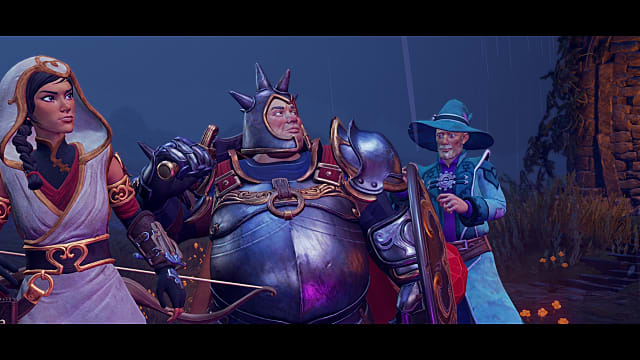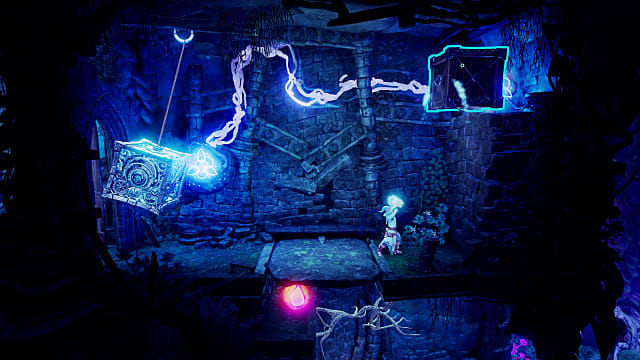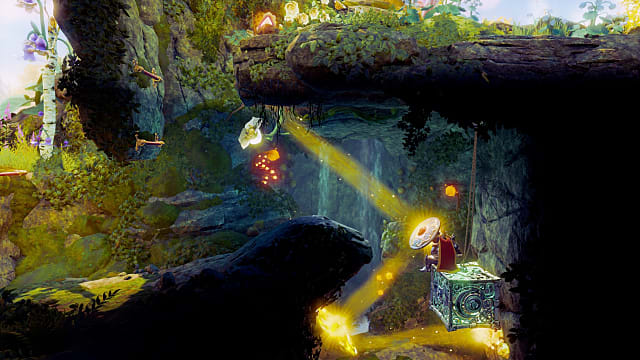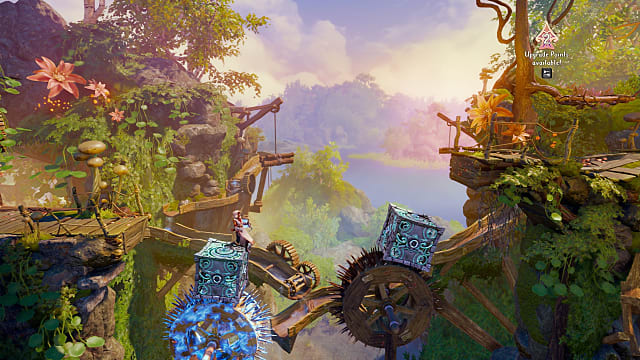

It’s a little weird that there’s a fourth Trine at all. It’s not because the games are bad – they mostly aren’t – but it makes a certain sense that a game called Trine, built around a trio of heroic characters, would end as a trilogy. A fourth game feels like it’s a violation of the theme.
Here we are again, though, on pleasantly familiar ground. If you’ve played a Trine game before this, then you more or less know what to expect from Trine 4: The Nightmare Prince. Like its predecessors, Trine 4 is an entertaining, low-stakes puzzle-platformer, starring its old familiar cast, that mostly tests your brain more than your reflexes, set in a colorful storybook of a fantasy world.
You play as three characters at once – wizard Amadeus, Zoya the thief, and armored knight Pontius, known collectively as the “heroes of Trine” – who are approached by the administration at a wizarding academy to bring back a wayward student.
That student, Prince Celius (from developer Frozenbyte’s 2017 game Nine Parchments, so Trine 4 is two sequels at once), has proven too impatient to get a handle on his dream powers. Now he’s on the run, pursued by a host of nightmare monsters that he’s also responsible for conjuring.
It took me a couple of hours to realize it, but the interesting thing about Trine 4’s story is that it’s exactly what it appears to be. This is a straight-up fantasy story (no gimmicks) that doesn’t wink at the camera, revel in its own darkness, or try to mess with genre standards. It’s just a trio of heroes trying to help a kid out of some trouble because they’re heroes and that’s what they do. The end. It’s refreshingly straightforward.
Considering that, it is funny to look at the cover art, though. The first two Trine games have really dark covers that suggest they’re atmospheric mid-2000s European CRPGs. The third features key art of the three heroes that makes it look like a fantasy take on Broken Sword or some other character-driven adventure series.
Now, with Trine 4’s cover, Amadeus, Zoya, and Pontius look like they’re just having the time of their damn lives. It might have taken a decade, but a Trine game actually has a cover that matches its mood.
Trine 4 is also one of the more elegantly paced puzzle-platformers I’ve ever played. It begins with three quick solo levels, to introduce each playable character and his or her unique abilities, then puts them together and takes off running.
Each area is a line of rooms that challenge you to use local features and your characters’ talents in new and different ways. Amadeus can conjure boxes, to use as stepping stones or ballast, and telekinetically move objects; Zoya has a bow and a grappling hook; and Pontius can use his shield to reflect projectiles and stomp to destroy weak floors. You control one of the three heroes at a time, and you can switch between them on the fly with the push of a button, using their abilities in concert with the environment to circumvent various obstacles.
As you go, you gradually run into new obstacles and areas, and unlock new character abilities, each one of which is explained in context in a way that doesn’t feel forced or blatant. Trine 4 is actually a low-key master class in how to correctly do in-game tutorials. I only found one area in the entire game where part of the solution wasn’t something I’d explicitly already learned.
One of the stranger things about Trine 4 is that it doesn’t really feel scripted, for want of a better term. In a lot of games like it, you’re generally expected to find the one intended solution to each puzzle, and if you find another way through, it’s probably an exploit.
Trine 4 is a lot messier, particularly in the middle game, once you’ve got a few new abilities. I’ve played a lot of games where character abilities like Amadeus’s conjured boxes or Zoya’s tightropes would be limited to specific, labeled locations. In Trine 4, conversely, you’re implicitly expected to be constantly experimenting.
Most of the time, when I tried to do something crazy just to see if it would work, it did. I might have ended up building a rickety Rube Goldberg machine out of fairy ropes, conjured platforms, and environmental objects when all I had to do was jump a couple of times, but I got to that damn platform, and that’s what matters.
I’m considerably less enthused about the game's combat.
Every so often, as you progress through a level, you get thrown into an inescapable arena with a handful of Celius’s nightmare monsters. Each one has a specific pattern and a couple of quirks. They are easy to figure out on the fly, but you always end up crammed inside a small space with four to six of them at once. The controls just aren’t suited to that kind of sudden, frantic scramble for survival, and every time I got into a fight, I wished I didn’t have to.
It’s not particularly challenging, but it just doesn’t flow particularly well, and Trine 4 would be a much better game if the combat was replaced with anything else. You can gradually pick up several upgrades that ostensibly give you more options in combat, but that isn’t any kind of incentive.
Pros:
- One of the more well-paced puzzle-platformers I’ve ever played.
- It has a lot of faith in its audience. It’s a smart game for clever people.
- Colorful, friendly, and challenging. Great for adults and kids alike.
Cons:
- The game would be much better if it didn’t have combat at all. The system is simply a mess.
- The upgrade system feels like it’s there for the sake of being there.
- A lot of the music sounds like something you’d hear randomly at a Renaissance festival.
The rest of the game is good enough that I can still recommend Trine 4, but it’s a shame that it has to stop dead every so often for an irritating fight scene. It’s got a lot of teachable moments for level and puzzle design, it’s refreshingly straightforward about its own genre, and even the characters are surprisingly nuanced for what they are.
Trine 4 is a great little puzzle game, but you could replace the combat with anything else – cooking minigames, card matching, historical trivia contests, whatever – and it’d be a monumental improvement.
[Note: A copy of Trine 4: The Nightmare Prince was provided by Frozenbyte for the purpose of this review.]




0 comments:
Post a Comment